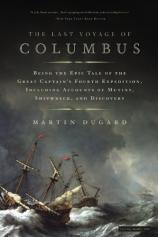Excerpt
Excerpt
The Last Voyage of Columbus: Being the Epic Tale of the Great Captain's Fourth Expedition, Including Accounts of Mutiny, Shipwreck and Discovery

CHAPTER ONE
THE VOYAGE THE WHOLE WORLD REMEMBERS
1492
The New World
Columbus’s problems began, ironically, with his greatest success. It was summer when Columbus first sallied forth across the ocean blue --- or ocean dark, as Spain’s more timid sailors called that vast unknown beyond the Pillars of Hercules. He was a forty-one-year-old Italian vagabond who had seduced the most powerful woman in Europe into paying for his outrageous journey. Spain’s hierarchy-obsessed nobility considered him a nothing, a no-account foreigner. Somewhere, Columbus had promised, not so far over the western horizon, lay the wealth to finance Spain’s wars of unification and conquest. The voyage could end either in death and disgrace or in a most sublime glory.
Columbus was a cheerful, confident man, prone to the occasional boast. Those traits belied a deep intensity: Columbus’s focus was so great while sailing or praying that he was oblivious to events going on around him. Yes, the world was round --- of that he had no doubt. But often his world was nothing more than himself. He was sure he would succeed.
Commanding a fleet of three small caravels --- the Niña, the Pinta, and the Santa Maria --- he departed Spain a half hour before sunrise on August 3, 1492.
Just three days out, the Pinta’s rudder floated loose, the result of sabotage by her fearful owner, who it turned out had been cowed into supporting the journey. The little Niña, spry and lithe but designed for coastal sailing, was coltish on the high seas. The fleet limped into port in the mountainous Canary Islands for an unscheduled, monthlong layover. The Pinta’s rudder was refastened. A bowsprit was added to the Niña, and her sail configuration changed from a triangular lateen to square-rigged so she would handle easier with the wind as it came from behind.
Columbus hoisted sail from the Canaries on September 6. Over the thirty-three days that followed, the crews, more accustomed to short Mediterranean trips, pleaded for him to turn back. When he refused, they threatened mutiny. Through it all, Columbus did not deviate from his westerly course. At 10 p.m. on October 11, vesper prayers still fresh on his mind, Columbus spied a light bobbing in the distance. Four hours later a lookout confirmed that it was not a lamp or fire on some distant ship but the white sands of what would be labeled the New World a year later, reflected by a dazzling moon. At dawn Columbus climbed carefully over the side of the swaying Santa Maria, into a waiting longboat. He was rowed ashore, where he claimed the land for the Spanish sovereigns. Before the voyage was over, he would claim several other islands for Spain.
He might as well have been claiming them for himself. Columbus received a royal reward of ten thousand Spanish maravedis (a maravedi being the modern-day equivalent of twelve pennies) for being the first among his crew to sight land. But that was really just the beginning. The Spanish sovereigns had been so desperate to best their Portuguese neighbors (many of whom, thanks to the intimacies of royal lineage, were also their cousins and distant relations) that they practically handed the New World to Columbus. Indeed, a pair of treaties dreamed up a decade earlier and brokered with Ferdinand and Isabella four months prior to his voyage had given the charismatic Genovese explorer an enviable financial stake in his discoveries. The so-called Capitulations of Santa Fe pledged Columbus control over lands “discovered or acquired by his labor and industry,” elevated him to the rank of admiral, and named him viceroy and governor-general of all lands in his new domain. Columbus, or a chosen subordinate, would be the sole arbitrator in all disputes between his new lands and Spain, particularly in reference to shipping traffic.
He would also receive one-tenth of all royal profits (including gold, pearls, spices, or gems) from his discoveries; the right to purchase an eighth percentage of a ship sailing to the new lands, in exchange for a further one-eighth profit from any goods said ship procured; and one-third of any profit due him from his new title as Admiral of the Ocean Sea. Spain, after fronting all the money, had effectively entered a partnership with the perseverant Genovese rather than gaining a colony outright. Columbus had lived on the financial bubble his entire life. Now he was about to become rich.
Or so he thought. On his journey back to Europe aboard the Niña in March 1493 (the flagship Santa Maria having foundered off the coast of Hispaniola and the lesser members of its crew sent ashore to build a fort in which to live until a relief ship arrived), a cyclone shredded his sails. The Niña was too crippled to make it all the way to Spain and limped into Lisbon for repairs. Portuguese King João II --- João the Perfect, as he was known --- had long kept Columbus at a distance. A decade earlier, he had twice turned down Columbus’s proposals for a New World voyage. But he now hastily cleared his calendar to receive the explorer. The king was bearded and sloe-eyed, with long delicate fingers that in March 1493 looked girlish. He was revered for his intellect and physical strength but also feared for his ruthlessness. Once, when a brother-in-law threatened his power, João ordered his relative’s immediate execution. When another later tried the same thing, João strangled the misguided relation with those deceptively fragile-looking hands.
João congratulated Columbus on his prescience and achievements and regaled him as a conquering hero. A knowledgeable, passionate advocate of nautical exploration, trained in its nuances, João listened with fascination and a growing rage to descriptions of the new lands Columbus was calling the Indies. Little did Columbus know, but he had stumbled into a diplomatic trap.
João’s great-uncle Henry the Navigator had begun Portugal’s crusade for maritime greatness, but it was João who had built an empire for his tiny nation. João recognized that Portugal lacked a limitless supply of natural resources and would eventually become Europe’s poor stepchild if it didn’t acquire colonies to provide trade goods. It was João’s maritime advisory committee, the Junta dos Matemáticos, that sent Diogo Cão farther south than any Portuguese ship had ever traveled when he was ordered to explore Central Africa in 1482. So after their meeting, as João bade Columbus farewell (over the objections of his advisers, who thought Columbus an insolent braggart and called for his execution), he knew as well as anyone the new shape of the world --- and its implications.
Columbus sailed from Lisbon’s enclosed harbor, down the Tagus River into the Ocean Sea, then south along the Portuguese coast on his way back to Spain. Meanwhile, before Columbus could so much as breathe a word of his find to Ferdinand and Isabella, João made the outrageous pronouncement that the Indies belonged to Portugal. Spain was trespassing. João’s argument was based on the Eighth Article of the 1479 Treaty of Alcaçovas, giving Portugal control of all lands south of the Canary Islands and opposite the African coast. Columbus’s bold new discoveries lay six degrees south of the Canaries; they were twenty-six hundred miles due east --- a distance greater than the width of Europe --- but south, nonetheless.
King Ferdinand and Queen Isabella had both ratified the Treaty of Alcaçovas, yet they howled in protest. Proving that they were João’s equal in gamesmanship, the Spanish sovereigns immediately invoked a Crusades-era statute permitting seizure of heathen lands by Christian rulers for the propagation of the Catholic faith. Columbus, being a devout Christian, had accomplished just such a thing, they argued. Then, instead of settling the matter through the give-and-take of traditional diplomacy (a give-and-take that could have cost Spain chunks of the New World), and well aware that Portugal’s naval might dwarfed that of Spain (which could allow the Portuguese to simply sail to the New World and take what they wanted), Ferdinand appealed to the one man whose opinion was beyond reproach: the pope.
The visionary, calculating Ferdinand had seen a heady future for himself at a young age, one with power extending far beyond the small provinces whose rule he inherited. Now he foresaw a great Spanish empire, transcending the Iberian Peninsula, extending west to Columbus’s New World and east to Italy. In taking his case to Rome, Ferdinand was seeking out a man who might share that same vision --- or at the very least, be so corrupt that he might be swayed on the sly.
Pope Alexander VI was the ideal choice. Born Rodrigo Borgia, the sixty-two-year-old pontiff was Spanish by birth and patriarch of the infamously corrupt Borgia clan. Alexander had uttered the Roman Catholic priest’s mandatory vow of celibacy at a young age but viewed it as mere formality to procuring fortune and sway. Alexander had fathered seven children out of wedlock. His current mistress was forty years younger than himself. He had not been selected pope in 1492 because of his piety or in the best interests of the Catholic Church but because he had purchased the position. Then, rather than change his hedonistic ways while following in the footsteps of St. Peter, Alexander delighted in orchestrating lavish bacchanals of food and sex within the Vatican palace. At one particular bash servants were ordered to keep track of each man’s orgasms; those satyrs displaying the most virility were awarded colorful silk tunics before stumbling back to their homes and wives.
To say that Alexander VI was morally pliable was an understatement. Add a deep affection for his ancestral roots (when Ferdinand and Isabella routed the Moors at Granada, Alexander defamed St. Peter’s Cathedral by staging a Spanish bullfight in its still-uncompleted courtyard), and the sovereigns had the perfect ally.
The decision of the pope, per custom, would be final.
Excerpted from The Last Voyage of Columbus © Copyright 2012 by Martin Dugard. Reprinted with permission by Little, Brown. All rights reserved.
The Last Voyage of Columbus: Being the Epic Tale of the Great Captain's Fourth Expedition, Including Accounts of Mutiny, Shipwreck and Discovery
- paperback: 320 pages
- Publisher: Back Bay Books
- ISBN-10: 0316154563
- ISBN-13: 9780316154567







